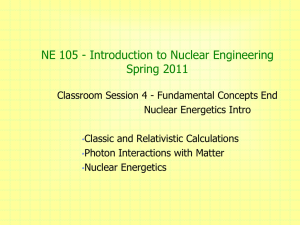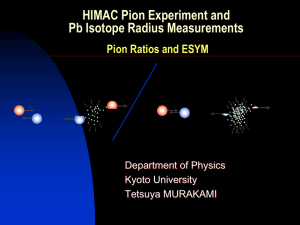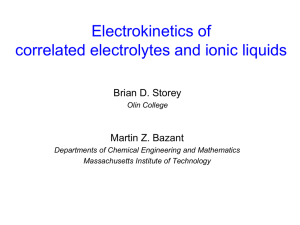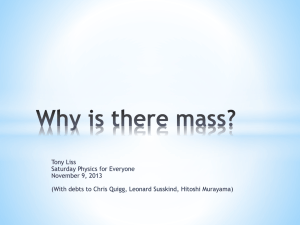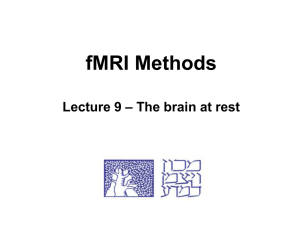G. Verde
advertisement
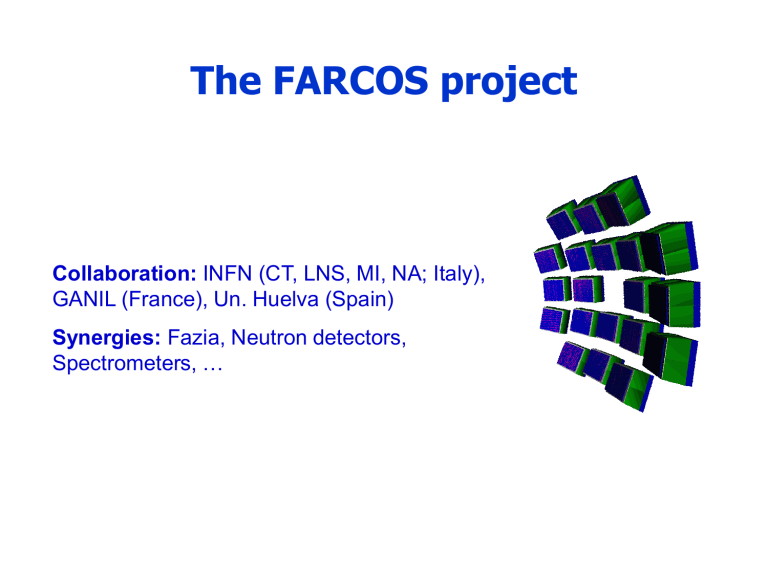
The FARCOS project Collaboration: INFN (CT, LNS, MI, NA; Italy), GANIL (France), Un. Huelva (Spain) Synergies: Fazia, Neutron detectors, Spectrometers, … Physics case: dynamics and spectroscopy 1. Imaging in heavy-ion collisions 2. Spectroscopy of exotic nuclei: – In heavy-ion collisions MPCS: Multi-Particle Correlation Spectroscopy – Direct reactions FARCOS: Femtoscope ARray for COrrelations and Spectroscopy Double-sided Silicon Strip 6.4 x 6.4 cm2 1500 m 300 m CsI(Tl) + D 32 x 32 32 x 32 Angular resolution: ~0.2o at d=60 cm Farcos as a modular correlator Correlations Event characterization (4) Coupling to 4 detectors for dynamics studies (LNS, GANIL, NSCL-MSU, …) Chimera @ INFN LNS Beam TARGET 30° 176° 1° 1m 1192 Si-CsI(Tl) Telescopes Particle identification (as in Chimera) PSD in CsI(Tl) ΔE(Si)-E(CsI) Z and A for light charged particles Charge Z for particles punching throught the Si detector Be HI t a V(t) 3He t slow d fast p CsI(Tl) Si ~300 μm 3-12 cm ΔE(Si)-ToF Mass for particles stopping in the Si detector E(Si)-Rise time ΔE(Si)-E(CsI) Charge Z and A for light ions (Z<9) punching throught the Si detector Li Charge Z for particle stopping in Si detectors (NEW) Farcos array features • High angular resolution (<0.5o): • Flexibility: allow coupling to – 4 detectors, magnetic spectrometers, other correlators – Neutron detectors for n-p correlations (future) • Low thresholds for low energy experiments at Spiral2 and Spes – pulse-shape on silicon and digitalization (future, interface to Fazia project) Density dependence of the asymmetry term in nuclear EoS E(, ) E , 0 Esym () B.A. Li et al., Phys. Rep. 464, 113 (2008) 2 n p n p ??? Many approaches… large uncertainties Microscopic many-body, phenomenological, variational Symmetry Energy: who cares? Lassa @ MSU Imbalance ratios skins halos FOPI @ GSI Elliptic flow resonances GDR & PYGMY RESONANCE Chimera @ LNS Competitiion Inc. Fusion / DIC Supernovae, neutron stars Producing density gradients Large N/Z to enhance effects of Esym() 124Sn+124Sn (N/Z=1.48), 48Ca+48Ca (N/Z=1.4), 197Au+197Au (N/Z=1.49) Sec. decays! Radioactive beams… n p Ebeam<100 MeV Pre-equilibrium n,p • n/p energy spectra and angular distributions Expansion Multifragmentation • Isospin diffusion, fractionation, isoscaling phenomena… • p-p, n-n and n-p correlation functions Chimera@INFN, Indra@GANIL, Lassa@MSU, … Heavy-ion collisions: open issues • Pre-equilibrium neutron/proton emissions: the most sensitive probes of Esym() – n/p relative energy spectra – p-p, n-p, n-n two-particle correlation functions • Space-time characterization: different particles emitted by several sources & over different time scales – Need space-time probes to disentangle sources t as short as 10-22 sec r as small as 1 fm “femtoscopy” Correlation femtoscopy in HIC Femtoscope 1 R(q) k p1 Ycoin p1, p2 qrel Yevt.mixing p1, p2 q p2 Sensitive to space-time properties a d p 1+R(q) p2 1+R(q) p1 6Li p proton-proton deuteron-alpha q (MeV/c) q (MeV/c) Low q (qrel) measurements Resonances High angular resolution required! Imaging correlations, “Femtoscopy” G. Verde et al., PRC65, 069604 (2002) R(q) 4 dr r 2 S(r) K(r,q) 14N+197Au E/A=75 MeV Fast simultaneous emitting sources (pre-equilibium) Slow sequential emissions (evap.) Source size Space-time images q e Source function: Spatial distribution of proton emitting source in HIC: “femtoscopy” - measuring sizes r~1 fm and times t~10-21s Farcos for complex particle correlations 6Li-a p-p 1+R(E*) d-a S(r) Images d-a a-6Li p-p E*(MeV) r (fm) Different particles emitted by different sources and at different times (hierarchy) Event characterization required ! ==> Coupling to 4 mandatory Multi-Particle Correlation Spectroscopy (MPCS) Not only EoS… 10C* Several unbound species in just one single experiment! Expansion HIC and correlations as a spectroscopic tool MPCS: 8B and 12C 8B p+7Be 12C aaa 12C aBe aa 3-alpha correlation function Spin of 8B states 12C states: sequential decay C+Mg, E=53 MeV/u Indra data F. Grenier et al., NPA 2008 LASSA data W.Tan, PRC 2004 J=1+ Event mixing Modified event mixing Accessing spins and branching ratios (sequential decay paths) Multi-a correlations: Hoyle and Boson condensate states 2a-2p correlations: states in 10C* 10C p-p-aa four-particle correlations 1+R(Ek) F. Grenier, A. Chbihi, G. Verde et al., Nucl. Phys. A811 (2008) 233 2 4 6 8 10 12 14 6Be 9B 8Be 10C 6Be+a (2p+a)a 10C 8Be+p (a+a)p 10C 9B+p (a+ap)p Ek (MeV) Disentangle sequential decay paths Symmetry energy and pp, nn and np correlations Symmetry potential 52Ca+48Ca Asy-stiff 7 Asy-soft E/A=80 MeV neutron-neutron 5 3 1 1+R(q) 1.5 pp Sources Asy-stiff: more localized source 1.0 0.5 0.0 4 proton-proton proton-neutron 3 2 1 q (MeV/c) Future perspectives: pp, nn, np correlations! Coupling to neutron detectors Neutron-proton correlation expts Ghetti et al, PRC 69 (2004) 031605 Protons neutron-proton Neutrons Emission chronology sensitive to Asy-EOS …difficult experiments n/p experiments @ MSU 112Sn+112Sn vs E/A=50 MeV 124Sn+124Sn M. Famiano et al., PRL97, 052701 (2006) n detectors Liquid scintillators p detectors DE-E (Lassa) M.B. Tsang et al., PRL102, 122701 (2009) Esym ( ) 0 n/p spectra ==> 0.7 Spectroscopy: “stand-alone” mode Shell structure close to drip lines Must2 expts Example: 8He beam @ Spiral (GANIL) E/A=15.4 MeV 8H + p 7He + d 8H + p 6He + t Similar experiments at LNS (FRIBS) or at LNL(SPES) Spes: low energies (Pulse shape on 1st Silicon) Spectroscopy: “coupling” mode FRIBS beams at the LNS of Catania Correlator 34Ar+p33Ar+d Chimera (d) (33Ar residue) d 34Ar 33Ar Day-1 experiment at the INFN-LNS Correlator • Heavy core: Magnex at ~ 0o • Scattered d with Correlator • Spiral/Spiral2, Spes, … Imaging correlations at low energies • Perspectives at Spiral2 and Spes: Imaging in fusion, fission, DIC, N/Z effects on limiting temperatures and reaction mechanisms, particle emission chronology Requires low identification thresholds: pulse-shaping techniques on silicon detectors • Chimera solution, Fazia implementation (digitalization of silicon signals) • Future issue: Pulse-shape capabilities in integrated electronics (ASIC, etc.) Workshop in 2011 • Catania, probably spring or early fall 2011 – Integrated electronics for silicon detectors, new solutions, pulse-shape in integrated solutions, coupling to different detectors (also neutrons, gammas, spectrometers, …), others You are all very welcome: need to build up synergies
